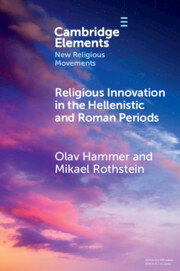Refine search
Actions for selected content:
44 results
Chapter 9 - Conclusion
- from Part II - Ethnography
-
- Book:
- Shapes in Revolution
- Published online:
- 07 November 2025
- Print publication:
- 20 November 2025, pp 265-284
-
- Chapter
- Export citation
4 - Loyalty and Patronage
-
- Book:
- Mantle of the Sufi Kings
- Published online:
- 27 November 2025
- Print publication:
- 06 November 2025, pp 113-133
-
- Chapter
- Export citation
Chapter 2 - Western Religious Cults
- from Section 1 - Typology
-
-
- Book:
- A Clinical and Forensic Guide to Cults and Persuasive Leadership
- Published online:
- 19 June 2025
- Print publication:
- 03 July 2025, pp 18-52
-
- Chapter
- Export citation
Chapter 3 - Cults of Personality
- from Section 1 - Typology
-
-
- Book:
- A Clinical and Forensic Guide to Cults and Persuasive Leadership
- Published online:
- 19 June 2025
- Print publication:
- 03 July 2025, pp 53-68
-
- Chapter
- Export citation
Chapter 11 - Effective Communication during a Health Emergency
- from Part IV - Crisis Leadership
-
- Book:
- Risk Communication in Public Health Emergencies
- Published online:
- 05 June 2025
- Print publication:
- 19 June 2025, pp 281-304
-
- Chapter
- Export citation
12 - Charismatic Speech Breathing
- from IV - Persuasion and Algorithms
-
-
- Book:
- Manipulation, Influence and Deception
- Published online:
- 10 June 2025
- Print publication:
- 24 April 2025, pp 250-276
-
- Chapter
- Export citation
Introduction
-
-
- Book:
- Cold War Asia
- Published online:
- 30 January 2025
- Print publication:
- 06 February 2025, pp 1-17
-
- Chapter
- Export citation

Tiberius and the Charisma of Augustus
- The Principate Enshrined
-
- Published online:
- 28 November 2024
- Print publication:
- 28 November 2024
11 - Regulatory Legitimacy
- from Part III - Evaluation
-
- Book:
- An Introduction to Law and Regulation
- Published online:
- 22 November 2024
- Print publication:
- 28 November 2024, pp 321-356
-
- Chapter
- Export citation
Conclusions
-
- Book:
- Tiberius and the Charisma of Augustus
- Published online:
- 28 November 2024
- Print publication:
- 28 November 2024, pp 207-209
-
- Chapter
- Export citation
Introduction
-
- Book:
- Tiberius and the Charisma of Augustus
- Published online:
- 28 November 2024
- Print publication:
- 28 November 2024, pp 1-6
-
- Chapter
- Export citation
Chapter 1 - Augustan Charisma and Its Transfer
-
- Book:
- Tiberius and the Charisma of Augustus
- Published online:
- 28 November 2024
- Print publication:
- 28 November 2024, pp 7-35
-
- Chapter
- Export citation
‘The Charismulator’ – charisma simulator: A study of a new VR intervention to improve charisma
-
- Journal:
- Journal of Management & Organization / Volume 31 / Issue 2 / March 2025
- Published online by Cambridge University Press:
- 11 November 2024, pp. 479-494
-
- Article
-
- You have access
- Open access
- HTML
- Export citation
Chapter 4 - The Tipping Point in Regime Collapse
- from Part II - Regime Change
-
- Book:
- The Psychology of Revolution
- Published online:
- 07 March 2024
- Print publication:
- 14 March 2024, pp 59-70
-
- Chapter
- Export citation
Chapter 9 - The Role of Personality in Revolutions
- from Part III - What Happens after Revolutionary Regime Change?
-
- Book:
- The Psychology of Revolution
- Published online:
- 07 March 2024
- Print publication:
- 14 March 2024, pp 133-152
-
- Chapter
- Export citation
10 - Kingship
- from Part II - Contexts
-
-
- Book:
- The Cambridge Companion to Alexander the Great
- Published online:
- 04 January 2024
- Print publication:
- 18 January 2024, pp 165-178
-
- Chapter
- Export citation
11 - The Rise of the Charismatic Nation: Romantic and Risorgimento Nationalism, Europe, 1800–1914
- from Part ii - Paradigm Shifts and Turning Points in the Era of Globalization, 1500 to the Present
-
-
- Book:
- The Cambridge History of Nationhood and Nationalism
- Published online:
- 27 October 2023
- Print publication:
- 09 November 2023, pp 231-255
-
- Chapter
- Export citation
7 - Imperial Ideology
- from Volume I Part 2 - Thematic Histories
-
-
- Book:
- The Cambridge History of the Mongol Empire
- Published online:
- 01 January 2024
- Print publication:
- 17 August 2023, pp 444-459
-
- Chapter
- Export citation

Religious Innovation in the Hellenistic and Roman Periods
-
- Published online:
- 24 July 2023
- Print publication:
- 10 August 2023
-
- Element
- Export citation
17 - Exemplars
- from Part III - Media and Modes of Ethical Practice
-
-
- Book:
- The Cambridge Handbook for the Anthropology of Ethics
- Published online:
- 11 May 2023
- Print publication:
- 25 May 2023, pp 433-459
-
- Chapter
- Export citation
